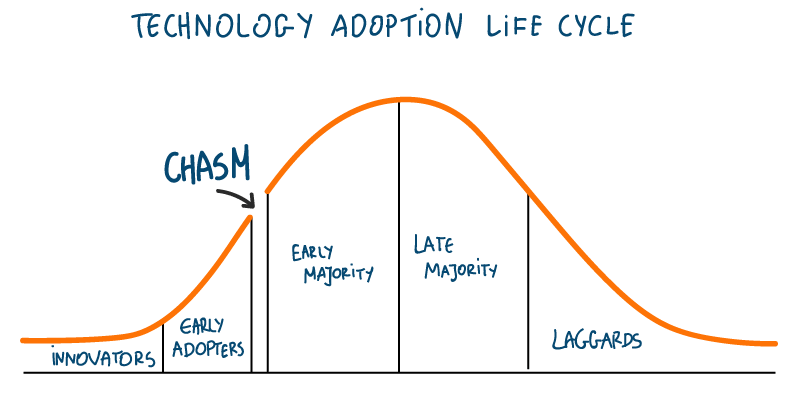20 years ago Geoffrey A. Moore published Crossing the Chasm, Marketing and Selling High-Tech Products to Mainstream Consumer — an exploration of user purchasing, adoption, and behavioral patterns. His foundation for a high-tech marketing model still rings true today, even though products, applications, platforms, and trends have accelerated in innovation, function, and capabilities.

Using a bell-shaped curve, Moore points to the user groups that purchase high tech products; the group begins at Innovators, moving to Early Adopters, Early Majority, Late Majority, and finishing with Laggards. The model works the curve from left to right, progressively winning each group of users. Between each segment, there is a crack — the largest crack, considered a “chasm,” occurs between the Early Adopters and the Early Majority.
This chasm is where most high tech ventures fail.
The Distinct Differences Between Early Adopters and the Early Majority
Early Adopters and the Early Majority groups are defined by distinct purchasing behavior and brand-product expectations.
Early Adopters are described as “visionaries” who relish the insight to “match emerging technology to a strategic opportunity. Early Adopters are driven by a dream, essentially a business goal (not a technology goal). They see the product’s potential and are willing to work with vendors who have little to no funding. Early Adopters are easy to sell to but difficult to please.
The Early Majority group members are described as “pragmatists” that care about the company they are buying from, the quality of the product, infrastructure support, and service reliability. They don’t like to buy from vendors who are not established; however, it is impossible to succeed without breaking into the mainstream market without Early Majority acceptance, references, and purchasing power.
Moore offers a strategy, designed in military ideology, to make an impactful break into the Early Majority segment and successfully cross the chasm.
The Strategy for Crossing the Chasm
Because the Early Majority requires a vendor to be conversant with issues that are of particular interest to their business, organizations must put extra time and effort into marketing the product to a specific industry. This includes events, public relations, partnerships and alliances, and references all targeted towards the niche segment. Drawing from a D-Day analogy, Moore has coined this one niche industry/market as the “beachhead.”
The goal is to use the beachhead as a springboard for further market-segment success.

Here are Moore’s four recommended steps for crossing the chasm via the beachhead-approach:
1. Target the point of attack by focusing all resources on achieving a dominant leadership position in that segment.
2. Assemble an invasion force by creating a whole product that anticipates customer’s problems and solutions in their entirety. This includes the core product plus everything else needed to achieve a compelling reason to buy (can be provided in-house or through strategic partnerships and alliances).
3. Define the battle through creating the competition, defining the position, developing an elevator pitch, and building key messaging into all company communications.
4. Launch the invasion through distribution and pricing. Direct sales are the optimal channel for high tech, as well as being the best channel for crossing the chasm.
After a successful acquisition and presence are established in the beachhead, the organization can move on to other strategic target market segments where the beachhead presents opportunity through entry points and connections.
In a marketplace that welcomes new ideas but chews through startups, the challenge to outlast the competition and gain consumers’ attention is a rigorous task. Through Moore’s proven approach by crossing the chasm to move further up the bell curve, companies can make an impact and break into a strategic market, as well as further their chances of long-term success.











